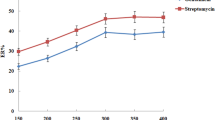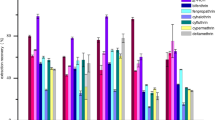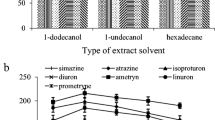Abstract
Dispersive liquid–liquid microextraction (DLLME) in combination with high-performance thin layer chromatography (HPTLC) is proposed as a green, and reliable technique for simultaneous determination of sodium dodecylbenzene sulfate (SDBS) and sodium dodecyl sulfate (SDS) as milk adulterations. The surfactant’s models were prepared in different concentration ranges (100–400 µg ml−1). At first, in DLLME procedure, the extraction conditions of anionic surfactants from milk were optimized by using central composite design (CCD). To obtain this purpose, volume of extraction solvent, speed of centrifuge and time of extraction were considered as effective factors. The proposed method needed only 5 ml of sample, and 500 µl of chloroform as microextraction solvent. Next, milk samples were analyzed by HPTLC. Subsequently HPTLC images were digitized and non-linear curve-fitting was implemented to the digitized measuring points chromatogram for elimination of random fluctuation, efficient denoising order to provide the reliable estimations of peak area. The fitted models were assessed by coefficient of determination (R2), adjusted coefficient of determination (Adj R2), sum of squares error (SSE), standard deviation (SD) and root mean square error (RMSE) which were estimated 0.97, 0.96, 0.001, 0.032 and 0.002 respectively. As a result, detection limits (LOD), limit of quantification (LOQ) and R2 for SDS and SDBS were 27, 33 µg ml−1 and 89, 94 µg ml−1 and 0.9932, 0.9917 respectively. The repeatability (RSD%) of the method for seven analyses and the extraction recovery were found to be 2.7–5.7% and 76.4–105.6% and 71–88.9% for SDS and SDBS respectively.





Similar content being viewed by others
Data Availability
If requested, data will be made available.
References
L.D. Cassoli, B. Sartori, P.F. Machado, The use of the Fourier transform infrared spectroscopy to determine adulterants in raw milk. Rev. Bras. Zootec. 40, 2591–2596 (2011). https://doi.org/10.1590/S1516-35982011001100042
B.M.A. De Carvalho, L.M. De Carvalho, J.S. Dos Reis Coimbra, L.A. Minim, E. De Souza Barcellos, W.F. Da Silva Júnior, E. Detmann, G.G.P. De Carvalho, Rapid detection of whey in milk powder samples by spectrophotometric and multivariate calibration. Food Chem. 174, 1–7 (2015). https://doi.org/10.1016/j.foodchem.2014.11.003
P. Jaiswal, S.N. Jha, J. Kaur, A. Borah, Detection and quantification of anionic detergent (lissapol) in milk using attenuated total reflectance-Fourier transform infrared spectroscopy. Food Chem. 221, 815–821 (2017). https://doi.org/10.1016/j.foodchem.2016.11.095
Y. Lu, Y. **a, G. Liu, M. Pan, M. Li, N.A. Lee, S. Wang, A review of methods for detecting melamine in food samples. Crit. Rev. Anal. Chem. 47, 51–66 (2017). https://doi.org/10.1080/10408347.2016.1176889
E. Hosseini, J.B. Ghasemi, B. Daraei, G. Asadi, N. Adib, Application of genetic algorithm and multivariate methods for the detection and measurement of milk-surfactant adulteration by attenuated total reflection and near-infrared spectroscopy. J. Sci. Food Agric. (2020). https://doi.org/10.1002/jsfa.10894
C. Cavin, G. Cottenet, C. Blancpain, T. Bessaire, N. Frank, P. Zbinden, Food adulteration: from vulnerability assessment to new analytical solutions. Chimia (Aarau) 70, 329–333 (2016). https://doi.org/10.2533/CHIMIA.2016.329
C. Moore, J. Spink, M. Lipp, Development and application of a database of food ingredient fraud and economically motivated adulteration from 1980 to 2010. J. Food Sci. 77, R118–R126 (2012). https://doi.org/10.1111/j.1750-3841.2012.02657.x
S. Oancea, Identification of glycomacropeptide as indicator of milk and dairy drinks adulteration with whey by immunochromatographic assay. Rom. Biotechnol. Lett. 14, 4146–4151 (2009)
S.N. Jha, T. Matsuoka, Detection of adulterants in milk using near infrared spectroscopy. J. Food Sci. Technol. 41, 313–316 (2004)
A. Rani, V. Sharma, S. Arora, D. Lal, A. Kumar, A rapid reversed-phase thin layer chromatographic protocol for detection of adulteration in ghee (clarified milk fat) with vegetable oils. J. Food Sci. Technol. 52, 2434–2439 (2015). https://doi.org/10.1007/s13197-013-1208-3
M.S.M.S.F. Acevedo, M.J.A. Lima, C.F. Nascimento, F.R.P. Rocha, A green and cost-effective procedure for determination of anionic surfactants in milk with liquid-liquid microextraction and smartphone-based photometric detection. Microchem. J. 143, 259–263 (2018). https://doi.org/10.1016/j.microc.2018.08.002
M. Ago, K. Ago, Y. Orihara, M. Ogata, A case of death associated with ingestion of liquid windshield-washer detergent, in Legal Medicine (Elsevier, 2003). https://doi.org/10.1016/S1344-6223(02)00095-0
S. Damodaran, K.L. Parkin, Fennema’s Food Chemistry, 5th edn. (CRC Press, Boca Raton, 2017). https://doi.org/10.1201/9781315372914
M.M. Paradkar, R.S. Singhal, P.R. Kulkarni, An approach to the detection of synthetic milk in dairy milk: 2. Detection of detergents. Int. J. Dairy Technol. 53, 92–95 (2000). https://doi.org/10.1111/j.1471-0307.2000.tb02667.x
M. Tay, G. Fang, P.L. Chia, S.F.Y. Li, Rapid screening for detection and differentiation of detergent powder adulteration in infant milk formula by LC-MS. Forensic Sci. Int. 232, 32–39 (2013). https://doi.org/10.1016/j.forsciint.2013.06.013
A.K. Barui, R. Sharma, Y.S. Rajput, S. Singh, A rapid paper chromatographic method for detection of anionic detergent in milk. J. Food Sci. Technol. 50, 826–829 (2013). https://doi.org/10.1007/s13197-013-0934-x
P. Kumar, P. Kumar, S. Manhas, N.K. Navani, A simple method for detection of anionic detergents in milk using unmodified gold nanoparticles. Sens. Actuators B 233, 157–161 (2016). https://doi.org/10.1016/j.snb.2016.04.066
E. Hosseini, J.B. Ghasemi, B. Daraei, G. Asadi, N. Adib, Near-infrared spectroscopy and machine learning-based classification and calibration methods in detection and measurement of anionic surfactant in milk. J. Food Compos. Anal. (2021). https://doi.org/10.1016/j.jfca.2021.104170
A. Sadat, P. Mustajab, I.A. Khan, Determining the adulteration of natural milk with synthetic milk using ac conductance measurement. J. Food Eng. 77, 472–477 (2006). https://doi.org/10.1016/j.jfoodeng.2005.06.062
M. Tohidi, M. Ghasemi-Varnamkhasti, V. Ghafarinia, S. Saeid Mohtasebi, M. Bonyadian, Identification of trace amounts of detergent powder in raw milk using a customized low-cost artificial olfactory system: a novel method. Measurement 124, 120–129 (2018). https://doi.org/10.1016/j.measurement.2018.04.006
A. Mohammad, Qasimullah, M. Khan, R. Mobin, Thin-layer chromatography in the analysis of surfactants: at a glance. J. Liq. Chromatogr. Relat. Technol. 40, 863–871 (2017). https://doi.org/10.1080/10826076.2017.1377731
ISO—ISO 7875-1:1996—water quality—determination of surfactants—part 1: determination of anionic surfactants by measurement of the methylene blue index (MBAS) (1996). https://www.iso.org/standard/24784.html. Accessed 1 Jan 2023
M. Rezaee, Y. Assadi, M.R. Milani Hosseini, E. Aghaee, F. Ahmadi, S. Berijani, Determination of organic compounds in water using dispersive liquid–liquid microextraction. J. Chromatogr. A 1116, 1–9 (2006). https://doi.org/10.1016/j.chroma.2006.03.007
F. Rezaei, A. Bidari, A.P. Birjandi, M.R. Milani Hosseini, Y. Assadi, Development of a dispersive liquid–liquid microextraction method for the determination of polychlorinated biphenyls in water. J. Hazard. Mater. 158, 621–627 (2008). https://doi.org/10.1016/J.JHAZMAT.2008.02.005
L. Nie, C. Cai, R. Guo, S. Yao, Z. Zhu, Y. Hong, D. Guo, Ionic liquid-assisted DLLME and SPME for the determination of contaminants in food samples. Separations 9, 170 (2022). https://doi.org/10.3390/SEPARATIONS9070170
A. Bidari, M.R. Ganjali, P. Norouzi, Development and evaluation of a dispersive liquid–liquid microextraction based test method for quantitation of total anionic surfactants: advantages against reference methods. Cent. Eur. J. Chem. 8, 702–708 (2010). https://doi.org/10.2478/S11532-010-0032-0/MACHINEREADABLECITATION/RIS
M. Kamankesh, A. Mohammadi, Z.M. Tehrani, R. Ferdowsi, H. Hosseini, Dispersive liquid-liquid microextraction followed by high-performance liquid chromatography for determination of benzoate and sorbate in yogurt drinks and method optimization by central composite design. Talanta 109, 46–51 (2013). https://doi.org/10.1016/J.TALANTA.2013.01.052
U. Alshana, N.G. Göǧer, N. Ertaş, Dispersive liquid-liquid microextraction combined with field-amplified sample stacking in capillary electrophoresis for the determination of non-steroidal anti-inflammatory drugs in milk and dairy products. Food Chem. 138, 890–897 (2013). https://doi.org/10.1016/J.FOODCHEM.2012.11.121
H. Shaaban, Sustainable dispersive liquid–liquid microextraction method utilizing a natural deep eutectic solvent for determination of chloramphenicol in honey: assessment of the environmental impact of the developed method. RSC Adv. 13, 5058–5069 (2023). https://doi.org/10.1039/D2RA08221G
A. Mohammad, R. Mobin, Identification of co-existing cationic surfactants with preliminary separation on silica HPTLC plates using mixed aqueous sodium chloride-ethanol as eluent. Cogent Chem. 1, 10197978 (2015). https://doi.org/10.1080/23312009.2015.1019798
S.A. Bhawani, O. Sulaiman, R. Hashim, M.N. Mohamad Ibrahim, Analysis of surfactants by thin-layer chromatography: a review. Tenside Surfactants Deterg. 47, 73–80 (2010). https://doi.org/10.3139/113.110054/HTML
A. Amirvaresi, M. Rashidi, M. Kamyar, M. Amirahmadi, B. Daraei, H. Parastar, Combining multivariate image analysis with high-performance thin-layer chromatography for development of a reliable tool for saffron authentication and adulteration detection. J. Chromatogr. A (2020). https://doi.org/10.1016/j.chroma.2020.461461
N. Stanek, I. Jasicka-Misiak, HPTLC phenolic profiles as useful tools for the authentication of honey. Food Anal. Methods 11, 2979–2989 (2018). https://doi.org/10.1007/s12161-018-1281-3
R. Rani, S. Medhe, M. Srivastava, HPTLC-MS analysis of melamine in milk: standardization and validation. Dairy Sci. Technol. 95, 257–263 (2015). https://doi.org/10.1007/S13594-014-0204-3
X. Zhang, J. Zheng, H. Gao, Curve fitting using wavelet transform for resolving simulated overlapped spectra. Anal. Chim. Acta 443, 117–125 (2001). https://doi.org/10.1016/S0003-2670(01)01185-0
Y. Zheng, D. Tian, K. Liu, Z. Bao, P. Wang, C. Qiu, D. Liu, R. Fan, Peak detection of TOF-SIMS using continuous wavelet transform and curve fitting. Int. J. Mass Spectrom. 428, 43–48 (2018). https://doi.org/10.1016/j.ijms.2018.03.001
P. Borman, D. Elder, Q2(R1) validation of analytical procedures, in ICH Quality Guidelines (2017). https://doi.org/10.1002/9781118971147.CH5
M.K. Gupta, A. Ghuge, M. Parab, Y. Al-Refaei, A. Khandare, N. Dand, N. Waghmare, A comparative review on high-performance liquid chromatography (HPLC), ultra performance liquid chromatography (UPLC) & high-performance thin layer chromatography (HPTLC) with current updates. Curr. Issues Pharm. Med. Sci. 35, 224–228 (2022). https://doi.org/10.2478/CIPMS-2022-0039
R. Basharat, V. Kotra, L.Y. Loong, A. Mathews, M. Kanakal, C.B.P. Devi et al., Ultra performance liquid chromatography (mini-review). Orient. J. Chem. 37(4), 847–857 (2021)
Acknowledgements
The authors thank the Food and Drug Control Laboratory staffs, Food and Drug Deputy, Ministry of Health and Medical Education, Tehran, Iran.
Author information
Authors and Affiliations
Corresponding author
Ethics declarations
Conflict of interest
All authors declare no conflict of interest.
Additional information
Publisher's Note
Springer Nature remains neutral with regard to jurisdictional claims in published maps and institutional affiliations.
Rights and permissions
Springer Nature or its licensor (e.g. a society or other partner) holds exclusive rights to this article under a publishing agreement with the author(s) or other rightsholder(s); author self-archiving of the accepted manuscript version of this article is solely governed by the terms of such publishing agreement and applicable law.
About this article
Cite this article
Hosseini, E., Nateghi, L. & Daraei, B. Application of non-linear curve-fitting to develop dispersive liquid–liquid microextraction followed by HPTLC for determination of milk-surfactant adulteration. Food Measure 18, 1517–1527 (2024). https://doi.org/10.1007/s11694-023-02251-6
Received:
Accepted:
Published:
Issue Date:
DOI: https://doi.org/10.1007/s11694-023-02251-6




